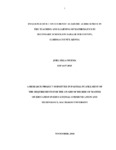| dc.description.abstract | Mathematics is a cluster subject that acts as a determinant to the enrollment into a multitude of career courses in Kenya and other countries around the world. This explains why concerted efforts are being made by the government and other stakeholders in education to improve students’ achievement in the subject. This study aimed at establishing the influence of information and communication technology on students’ academic performance in mathematics in public secondary schools in Dadaab sub-county Garissa County. The specific objectives of the study were: to establish the influence of teaching method on student’s achievement in mathematics, to determine the influence of teachers attitude towards ICT on students’ achievement in mathematics, to establish the influence of the availability of ICT equipment on the students’ achievement in mathematics and to establish the influence of teachers’ competence on ICT on students’ achievement in mathematics. The study was based on a conceptual model developed by Shavelson; McDonwell and Oakes (1987). The study adopted quasi experimental research design but with mixed approaches of data collection. The study targeted head teachers, mathematics teachers and students in all public secondary schools in Dadaab sub-county, Garissa County. 30% of the students’ constituted the study sample. Purposive sampling was used for the principals and mathematics teachers. Achievement tests, structured questionnaires, and interview guides were used to collect both qualitative and quantitative data from respondents. Pre-testing was conducted to determine the validity of the instruments. Reliability was assessed through test-retest technique. Pearson’s product moment correlation coefficient was computed to determine reliability. Qualitative data was thematically coded and quantized before entering into SPSS program, along with the quantitative data. Data was then analyzed descriptively and inferentially. Descriptive statistics involved determining the means, modes and standard deviations while inferential statistics involved the determination of Pearson correlation coefficient, T-tests for independent samples and chi-square of independence. The analyzed data was then presented using tables, charts and graphs. The study established positive correlations between teaching methods and student achievement in mathematics implied that ICT was a better determinant of student achievement compared to traditional methods. The Chi square analysis established no asymptotic relationship between teachers’ attitudes towards ICT and students’ achievement in mathematics. Similarly, teachers’ perceptions towards ICT were not associated to academic achievement in mathematics. | en_US |

